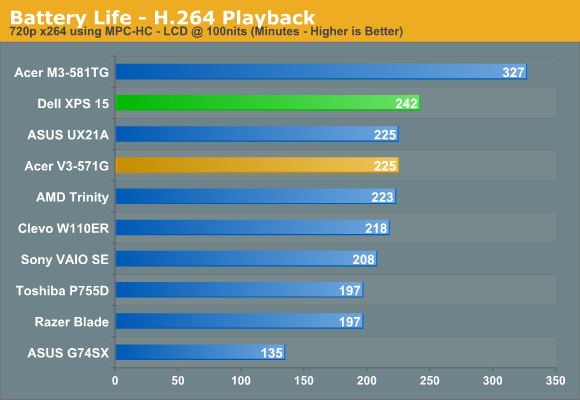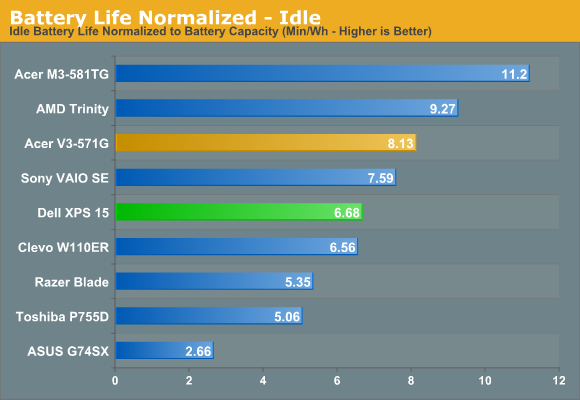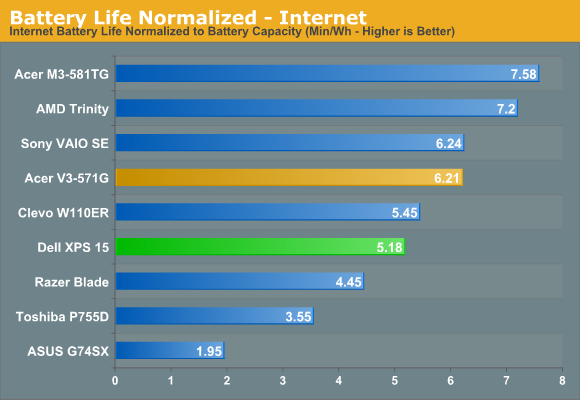Dell XPS 15 L521X: A Detailed First Look
by Jarred Walton on July 25, 2012 1:10 AM ESTDell XPS 15 Battery Life
Dell uses a 9-cell, 65Wh integrated battery in the XPS 15 that’s not user replaceable, which is similar to what we’ve seen in the previous generation XPS 15z as well as the MacBook Pro 15. Apple uses a higher capacity battery, and under OS X the MBP15 will generally offer superior battery life, but unless something has changed since our last look we would expect greatly decreased battery life under Windows via Boot Camp. Since the XPS 15 is designed to run Windows from the ground up, there isn’t a problem with lack of power optimizations, and the result is competitive battery life. The LCD was set to 50% brightness (109 nits) for our battery testing—or nine steps down from maximum if you’re using the keyboard shortcut.






Idle battery life is just over seven hours, with a normalized result putting the XPS 15 ahead of everything except Ultrabooks and AMD’s Trinity. Put a more typical load on the laptops, like our Internet test, and we’re at five hours of useful battery life. If you’re doing lighter web surfing with a mix of office applications, you can expect somewhere around six hours of battery life. As for video playback, Dell manages just over four hours of 720p H.264 decoding; 1080p H.264 decoding drops that slightly to around 3.5 hours. That’s actually one of the lower results for battery life considering the battery capacity, though it’s worth noting that playback on higher resolution displays ends up being more taxing as there are more pixels to push. Overall, then, battery life is good and will be sufficient for most people to get through a day’s work without plugging in, particularly if they let the LCD turn off and/or the laptop go to sleep during periods of inactivity.










109 Comments
View All Comments
CeriseCogburn - Sunday, July 29, 2012 - link
Looks like the truth is less than half on not so old macshttp://www.ebay.com/itm/Mac-Book-Pro-17-2-3Ghz-i7-...
BillatDell - Wednesday, July 25, 2012 - link
Very fair review, all things considered, Jarred. Thank you very much. I am the Dell employee you linked to out on Notebook Review Forums.I am wondering if skin temps matter to you and the Anandtech audience. I'd be curious to see a skin temp comparison under similar loads between the XPS and any competitive system, particularly the rMBP and MBP. It may not have any impact on anyone's buying decision if they don't see the numbers, but it may or may not matter to others if there turns out to be a wide disparity. Hard to tell if the cost/benefit analysis of our having a hard set skin temp spec across the board for all platforms stands to reason, given pretty much universal approval of how the MBP performs and the obvious lack of popularity with our current thermal/throttling scheme.
Anyone else have any thoughts on skin temps, or is it a non-factor? I'm interested to hear and get some thoughts out here on the record.
Great community. Great site. Thanks for all you do.
yyrkoon - Wednesday, July 25, 2012 - link
If I understand what you mean by "skin-temps" Bill. No for me personally it does not matter. The laptops I use currently serve as desktop replacements. As we are completely off-grid using solar, wind, and sometimes generators.However, I would admit. That we are not the norm for most users.
My own personal concerns are getting what I paid for but, stability first. Just for example. I like to play a lot of games, but have many computer related hobbies. So gaming performance for me tends to be my own benchmark. Of course I also have a price range I tend to stick within.
Unfortunately for me, and Dell. The XPS series is generally out of my own price range. However that could change. With that said, I have been keeping an eye on your companies products. Specifically the XPS mobile line.
JarredWalton - Wednesday, July 25, 2012 - link
Hi Bill, glad to have you on here. Skin (surface) temperatures are something I used to report, but them my thermometer broke and we added a couple more laptop reviewers and I figured I would just forget it and use internal temperatures. What I'd REALLY love to get is one of those digital thermal imaging cameras, but sadly they're a bit too much for me to convince Anand to buy a couple.As for what I think of skin temps, there's a balance that needs to be maintained, and certain areas can get hotter without bothering the user as much. If we're looking at a desktop replacement, it's not too big a concern, but for the more portable systems I definitely feel it's important. Ideally, I want the palm rest, keyboard, and the bottom "thigh" areas to be cooler, while the rear of the laptop (e.g. where the vent is on the XPS 15) can be hotter. 35C or less is generally what I'd like, but I live in WA so temperatures aren't as hot as, say, AZ or CA. If I were living in a hotter climate, I'd probably want even cooler running laptops.
Anyway, as you can probably glean from the review, I'd say you need stability as well as the ability to hit the rated performance on all parts. For the CPU, that means CPU clocks of 2.1GHz or higher regardless of workload should be possible pretty much indefinitely--and certainly if you're in a 75F or cooler environment. If the heatsink/fan can't keep the CPU and GPU at acceptable temperatures under load, then the hardware has been over-specced for the cooling. (We saw this exact same issue on Acer's TimelineX 3830TG, incidentally. Thin and light with reasonably fast hardware, but with gaming workloads the CPU would drop to 1.2GHz.)
My one thought that I keep coming back to on the XPS 15 is that it simply needs a higher RPM fan. Maybe the BIOS can kick the fan speed up one more level, but right now it just doesn't seem capable of cooling effectively at the current maximum RPM. A more drastic change would involve looking at the exhaust and trying to make that "breath" easier, as right now the bottom of the LCD/hinge seems to restrict airflow. Would either of these items be enough to fix the throttling problem? I don't know, but I am very surprised that this wasn't caught and addressed before retail units were shipping to the public.
Here's hoping we'll get a reasonable firmware fix in the near future!
Voldenuit - Wednesday, July 25, 2012 - link
OK, off the bat, I want to apologize for sounding like a broken record.But I was vocally unhappy with the Acer sporting a TN panel at $1400, and I'm even more unhappy with the Dell doing the same thing at $1700. What makes manufacturers think they could (or should) get away with foisting this sort of crap on people?
Next time I should just skip to the LCD page before reading any further. :/
Grok42 - Wednesday, July 25, 2012 - link
I agree. My preference of OS in order is Linux, Windows, BeOS, OS X. I also hate laptops as they are typically slower, hotter and cost more than a desktop. That said, as of today my next computer will probably be a rMBP because of the screen. My profession is computers and ~$1000 is nothing compared to what I will gain with a better tool with which to do my work. The PC industry better wake up and start offering multiple 4k displays or they are going to be wiped out.Doomtomb - Wednesday, July 25, 2012 - link
I like Dell and I want to see them succeed in the consumer/enterprise PC market. However, this review of the new 2012 Dell XPS 15 reminds me of the same niggles I had with my Studio XPS 16 purchased in early 2010. The one area that my Studio XPS 16 will always dominate is display (RGB-LED 1080p) displays colors perfectly unlike the XPS 15. Both of these computers are very premium products with price tags to match. The problems with the Studio XPS 16 were build quality (lousy hinges, seems between aluminum parts), heavy, battery life, and heat. It tries to push the boundaries between size, style, build quality, and performance but you can't have it all. It ended up being too big and heavy and just not quite as powerful as my friend's Alienwares. The battery life was also sub-par for class. I'd just rather recommend getting a thin and light, a gaming desktop replacement, or a MacBook with Retina Display.antef - Wednesday, July 25, 2012 - link
After the ridiculous overheating and throttling (to the point of an unusable machine) I've experienced with my Dell Precision, and reading this article with similar concerns, I can't imagine I'll be trusting a Dell for any high-performance workloads anytime soon.Death666Angel - Wednesday, July 25, 2012 - link
I was going to comment on how the MBP 15" gets mentioned in nearly every paragraph without being in the charts. Then I thought: "Well, they do have the Bench for those things." So I went there trying to compare this with the MBP 15" 2012. But you don't have the Dell there (yet) and you have no Apple 15" of any sort in there. How come? :-)tipoo - Wednesday, July 25, 2012 - link
Indeed, I'd like some macs on there